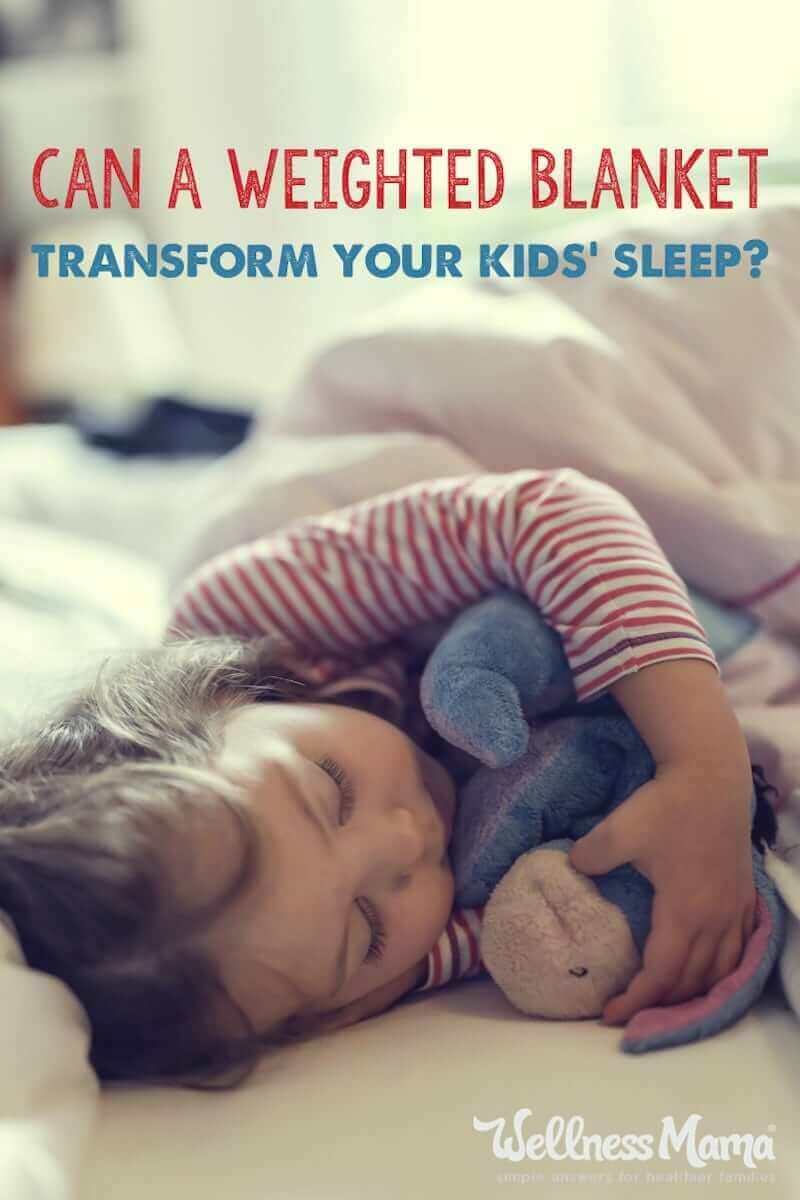Let’s be honest… as moms, we will do just about anything to get our kids to sleep. Sleep is what makes a parent’s world go ’round. We need good sleep, and we desperately need our kids to get good sleep, too. Recently, I’ve begun reading about how a weighted blanket may be able to help kids sleep better.
While there are lots of natural remedies that can help kids sleep, like tart cherry juice, breathing techniques, and inversions (read more about those tricks here), weighted blankets provide restful sleep on a different level.
What Is a Weighted Blanket?
Weighted blankets are specially made blankets that contain a weighted material, usually some kind of plastic bead, sewn into a grid design to be dispersed evenly throughout the blanket, between two layers.
Blankets can be made in differing weights to accommodate the size of the user. Even small children can enjoy lighter weighted blankets, while bigger kids will need heavier blankets.
Why Use One?
Weighted blankets have been shown to be beneficial for anyone having trouble sleeping, as well as those suffering from anxiety or ADHD. They are an especially non-invasive way to help children who have trouble falling asleep.
Who Needs One?
Weighted blankets especially benefit those suffering from anxiety or insomnia. They are particularly helpful for children on the autism spectrum, who crave touch and pressure but are unable to tolerate typical physical touch from loved ones.
These children become sensory-seeking because, although they need stimulation, they cannot endure hugs and squeezes that neurotypical kids enjoy. Temple Grandin, a noted animal expert and advocate for those on the autism spectrum (and autistic herself) recalls the sensation of being touched as a child:
I would stiffen and pull away when people touched me, and I was oversensitive to both touch and sound…
Temple went on to complete a study of a device she built, called the “Squeeze Machine,” which exerted deep touch pressure to users. The study found that deep touch pressure benefited children with autism and ADHD by calming them. It also reduced self-injuring and stimulatory behaviors.
Studies have also found that babies, especially those born prematurely, benefit from deep touch pressure. As for the calming effects of a weighted blanket for sleep, Temple reports: “A high functioning autistic woman stated, ‘I need heavy blankets on me to sleep well, or else my muscles won’t calm down.’”
Weighted blankets provide the calming touch those on the spectrum need, in a way they can receive it.
Can Weighted Blankets Benefit Neurotypical Children?
While it may seem that weighted blankets are clearly a help for children on the spectrum who need the calming effect of the weights, weighted blankets can benefit all children.
Parents have reported that, despite the blankets being originally designed to benefit children on the autism spectrum and with sensory processing disorder, their children without such a diagnosis have experienced extraordinary benefits from using a weighted blanket, primarily in the form of better sleep.
A writer for Forbes Magazine reports: “When word got out among parent friends at my son’s school that weighted blankets were turning moody 10-year-olds into well-rested angels, everyone started tucking in.” He goes on to say his 10-year-old son began sleeping more soundly and waking up happier and more focused after regularly using a weighted blanket, and that other parents reported similar results.
Can Weighted Blankets Help Adults?
These blankets can also help adults sleep more deeply. My husband tracks his sleep using an Oura ring and wasn’t getting enough deep sleep. Adding an adult weighted blanket and ChiliPad helped improve his sleep scores and he feels more rested.
How They Work
The pressure from a weighted blanket on the skin activates sensory systems, which in turn affects the brain. In response to the additional pressure, the brain releases neurotransmitters like serotonin and dopamine, which improve mood and induce a calming effect.
For jittery kids who spend all day at school or too much time indoors during cold winter months, a weighted blanket may be an important tool when creating a calming bedroom and nighttime routine. The deep touch pressure provided by weighted blankets calms the nervous system as well, which is necessary for good sleep.
How to Find a Good Weighted Blanket
Weighted blankets have become common enough that you can find them easily online.
What to look for:
- Choose a fabric your child will enjoy; many weighted blankets are made from a soft minky or fleece material.
- Pay attention to weight; blankets should typically weigh between 5-10% of your child’s body weight plus 1 or 2 additional pounds, though suggestions vary.
- Choose a blanket size that will work for your child; sizes can range from a small lap blanket to ones large enough to cover a bed.
A 9-12 pound weighted blanket is generally recommended for children. Here are some good choices:
- Weighted Evolution – Reasonably priced and we love the weight/color options and the quality of this blanket. It uses glass beads (instead of plastic) and the weight is evenly distributed and super comfortable.
- Sensory Goods Blanket – On the pricier side but it is organic and plastic-free. Variety of sizes and weights.
- LUNA Weighted Blanket – Hypoallergenic and has Certified Oeko-TEX Cotton with non-toxic glass beads.
- Harkla Blanket – Not organic or natural fabric but this one is super soft and the filling is plastic-free.
- ChilSleep – They have a weighted blanket with a cooling option.
The good news is, if these options aren’t in the budget and you can sew, it’s not very hard to make your own custom blanket!
Here’s how:
How to Make a DIY Weighted Blanket
If you’re familiar with simple sewing techniques, you may be able to try your hand at making your own weighted blanket (you might even be able to make a t-shirt quilt keepsake using this tutorial).
Most pre-made blankets contain plastic beads and I’m not a fan of plastic (to put it gently). Avoid the plastics and all their endocrine disruptors by making your own with an alternative substance like rice or beans. Of course, using rice and beans makes the blanket non-washable so consider this as well.
Items You’ll Need:
- a sewing machine
- fabric: a nice, soft fabric like cotton fleece, in a pattern your child will enjoy is perfect. Patterns with lines like plaid make it easier to sew a straight line and make your grids even. Determine the size you’ll need and plan accordingly, getting enough for two layers.
- rice or polypropylene beads for filling (not washable if you use rice!)
- matching thread
- a kitchen scale
- a funnel
Instructions to Make:
- Prepare the fabric by making sure the layers are even.
- Stitch the bottom and two sides of the blanket together. Use binding or tuck in the edges to create a hem.
- With a fabric pencil, mark off the grid design on the fabric.
- Divide the poly beads by the number of boxes in your grid and determine how much will go in each box.
- Sew the vertical lines of the grid from the bottom hem to almost the top of the blanket, leaving a couple inches at the top.
- Pour enough beads in each row for one box.
- Sew the horizontal line over each scoop of beads in the blanket to create the first row.
- Repeat until you get to the top of the blanket, then finish the vertical lines at the top and hem the final edge to finish the blanket.
For a super detailed tutorial, complete with pictures, check out these instructions here.
Try a Weighted Blanket
Whether you choose to go the DIY-route or buy a ready-made blanket, there’s good reason to try a weighted blanket to help your kids sleep better. The calming, soothing pressure that a weighted blanket provides can help children with processing disorders, or kids who just need a little help to fall asleep or calm down after a long day.
Here’s to better sleep, which I think is every parent’s dream!
This article was medically reviewed by Madiha Saeed, MD, a board certified family physician. As always, this is not personal medical advice and we recommend that you talk with your doctor.
Do you think a weighted blanket would help your child sleep better? Share your experience in the comments!



Leave a Reply